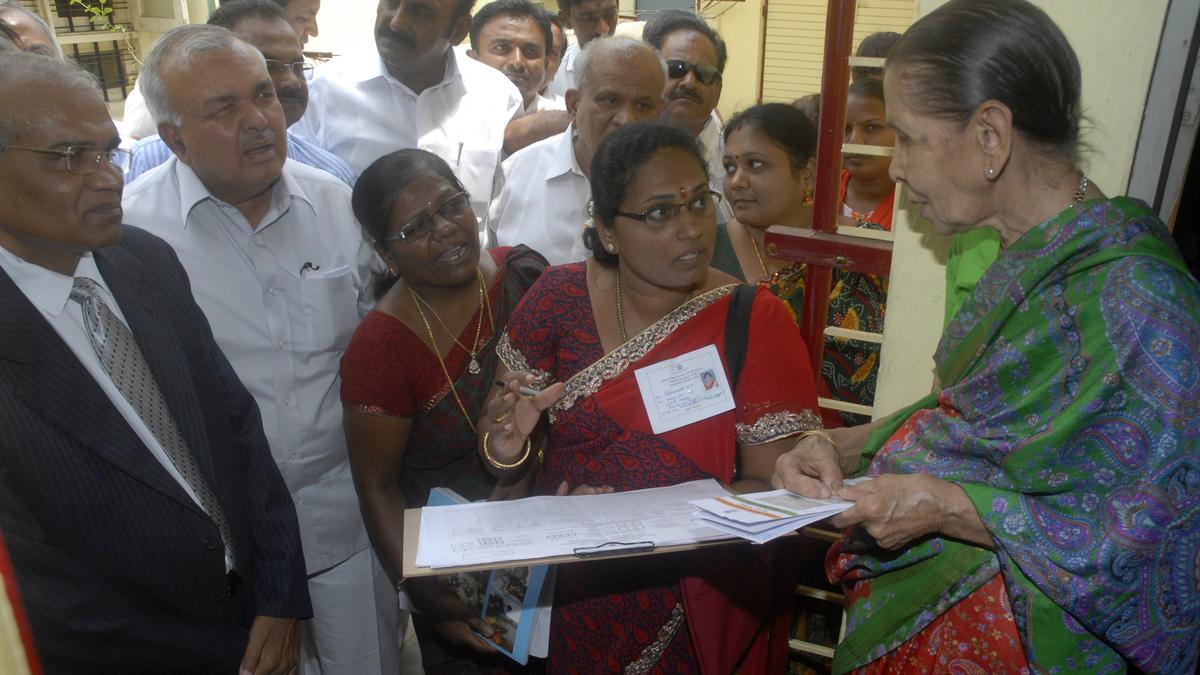
Transport Minister Ramalinga Reddy, president of Karnataka State Commission for Backward Classes H. Kantharaj, and a team of enumerators at the inuguaration of the caste census in Bengaluru in 2015. The survey has put the population of Veerashaiva-Lingayats in Karnataka to be about 66.35 lakh of the 5.98 crore surveyed, or about 11% of the State population.
| Photo Credit: file photo
Veerashaiva-Lingayats, who are contesting the population data in the 2015 Socio-Economic and Educational Survey report of the Karnataka State Commission for Backward Classes, are set to seek a separate religion code for the community in the national census that will commence in 2026.
The Akhila Bharatha Veerashaiva Mahasabha will petition the Centre for a religion code. The executive committee of the mahasabha will meet soon and draft the contents of the petition.
Political backdrop
The idea of a separate religion status for Lingayats had been a widely contested issue ahead of the 2018 Assembly elections in Karnataka. Though the Akhila Bharatha Veerashaiva Mahasabha has been seeking a separate religion code for the community for decades, the Jagathika Lingayat Mahasabha, which spearheaded an agitation in 2017, sought a separate religion tag for “Lingayats.”
Then Ministers in Chief Minister Siddaramaiah’s Cabinet, M.B. Patil and Vinay Kulkarni, were part of the campaign. While the demand for separate religion has come from both groups, the difference is over the nomenclature, a Veerashaiva mahasabha source explained, cautioning that the differences could crop up again with the Veerashaiva mahasabha set to seek a separate code for “Veerashaiva-Lingayats.”
In 2011, separate codes were assigned to Hinduism, Islam, Christianity, Sikhism, Jainism, and Buddhism. There was a separate column for “other religions and persuasions”. Ahead of the 2001 and the 2011 census too, the Veerashaiva mahasabha had petitioned the Centre seeking the religion code. But after being denied the same, the community members, through a “jana jagruthi jatha” were asked to write “Veerashaiva-Lingayat” in the column meant for “others” instead of identifying as Hindus, Veerashaiva mahasabha sources said.
Since 1940s
“Seeking a separate religion tag is not new. The Veerashaiva mahasabha in its 1940 conference at Kumbakonam had passed a resolution seeking separate religion tag for Veerashaiva-Lingayats and petitioned the then British government. Our record shows that even before the 1971 census, a similar demand had been made,” Veerashaiva mahasabha secretary H.M. Renuka Prasanna said.
The 2015 survey conducted by the commission, headed by H. Kantharaj, has put the population of Veerashaiva-Lingayats in Karnataka to be about 66.35 lakh of the 5.98 crore surveyed, or about 11% of the State population.
The Veerashaiva mahasabha has disputed the figure and claimed its number to be far higher around 18%-22% of the State population. The 2026 census will now be another measure for the population. The Veerashaiva-Lingayats are the dominant land-owning community in north and central Karnataka, and seen as politically powerful too, though it is part of backward classes Category 3B in the current OBC classification.
Apart from a sizeable population of broader Veerashaiva-Lingayat community spread across Karnataka, the Veerashaiva mahasabha is counting on the community’s considerable numbers in neighbouring Maharashtra, Tamil Nadu, Kerala, Andhra Pradesh, and Telangana.
Published – May 01, 2025 08:57 pm IST
Anurag Dhole is a seasoned journalist and content writer with a passion for delivering timely, accurate, and engaging stories. With over 8 years of experience in digital media, she covers a wide range of topics—from breaking news and politics to business insights and cultural trends. Jane's writing style blends clarity with depth, aiming to inform and inspire readers in a fast-paced media landscape. When she’s not chasing stories, she’s likely reading investigative features or exploring local cafés for her next writing spot.




